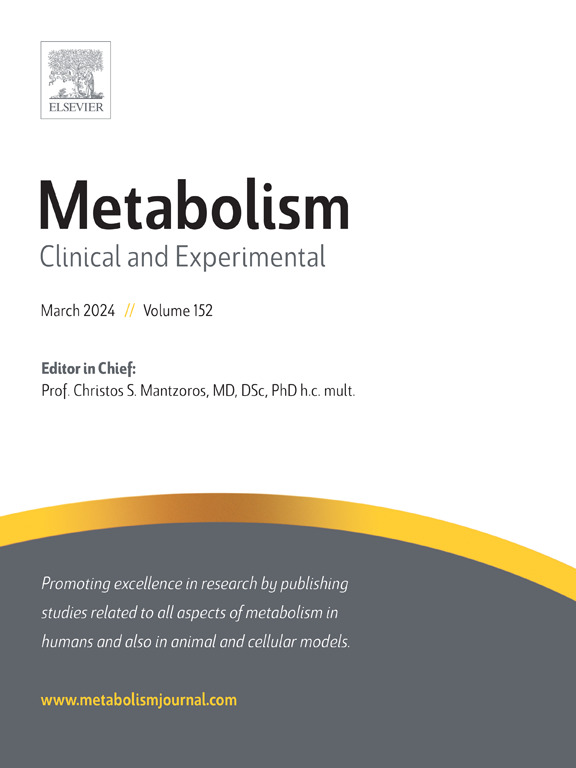Hexosamine biosynthesis dysfunction-induced LIFR N-glycosylation deficiency exacerbates steatotic liver ischemia/reperfusion injury
IF 10.8
1区 医学
Q1 ENDOCRINOLOGY & METABOLISM
引用次数: 0
Abstract
Background
More and more steatotic livers undergo resection or transplantation but they exhibit higher susceptibility to ischemia-reperfusion injury (IRI), which results in increased perioperative complication morbidity and mortality. IRI is driven by various cytokines and receptors, both of which are extensively modified by N-glycosylation. We aim to elucidate susceptibility of steatotic livers to IRI from the perspective of N-glycosylation.
Methods
Differentially expressed genes and glycoproteins were identified with RNA-seq and N-glycoproteomics. Myeloid LIF or hepatocyte LIFR knockout mice were developed to examine the function of LIF and LIFR. Modalities including phosphoproteomics, ChIP-seq, single cell RNA-seq, metabolomics and immunoblotting were utilized to investigate underlying mechanisms.
Results
LIF transcription in myeloid cells and LIFR N-glycosylation in hepatocytes were substantially induced by IRI of normal livers. LIF and LIFR protected normal livers from IRI through activating STAT3 and promoting downstream TNFAIP3 expression, which was facilitated by LIFR N-glycosylation. Mechanistically, N-glycosylation at N238 stabilized LIFR protein by disrupting TRIM28-mediated K48 ubiquitination at LIFR K254. Furthermore, N-glycosylation at N358/N658/N675 of LIFR facilitated LIF/LIFR/gp130 complex formation and subsequent signal transduction. However, in steatotic livers, myeloid cell LIF transcription was partially inhibited due to hepatic microenvironment L-arginine insufficiency, while hepatocyte LIFR N-glycosylation was defective due to intracellular UDP-GlcNAc exhaustion. Importantly, combined L-arginine and GlcNAc treatment reversed LIF expression and LIFR N-glycosylation insufficiency, which represents potential therapeutic strategy to protect steatotic livers.
Conclusions
LIF expression and LIFR N-glycosylation insufficiency aggravates steatotic liver IRI, which can be reversed by combined L-arginine and GlcNAc treatment.

己糖胺生物合成功能障碍诱导的LIFR n-糖基化缺乏加剧了脂肪变性肝缺血/再灌注损伤
背景越来越多的脂肪肝手术切除或移植,但其易发生缺血再灌注损伤(IRI),导致围手术期并发症的发病率和死亡率增加。IRI是由多种细胞因子和受体驱动的,它们都被n -糖基化广泛修饰。我们旨在从n -糖基化的角度阐明脂肪变性肝脏对IRI的易感性。方法采用RNA-seq和n -糖蛋白组学方法对差异表达基因和糖蛋白进行鉴定。培养髓系LIF或肝细胞LIFR敲除小鼠,检测LIF和LIFR的功能。利用磷酸化蛋白质组学、ChIP-seq、单细胞RNA-seq、代谢组学和免疫印迹等方法研究其潜在机制。结果正常肝脏IRI可显著诱导髓细胞内LIFR转录和肝细胞内LIFR n -糖基化。liff和LIFR通过激活STAT3和促进下游TNFAIP3表达来保护正常肝脏免受IRI,这是由LIFR n -糖基化促进的。机制上,N238的n糖基化通过破坏trim28介导的LIFR K254的K48泛素化来稳定LIFR蛋白。此外,LIFR的N358/N658/N675位点的n糖基化促进了LIF/LIFR/gp130复合物的形成和随后的信号转导。然而,在脂肪变性肝中,由于肝微环境l -精氨酸不足,髓细胞LIF转录受到部分抑制,而由于细胞内UDP-GlcNAc耗竭,肝细胞LIFR n -糖基化缺陷。重要的是,l -精氨酸和GlcNAc联合治疗逆转了LIF表达和LIFR n -糖基化不足,这代表了保护脂肪变性肝的潜在治疗策略。结论slif表达和LIFR n -糖基化不足可加重脂肪变性肝IRI,而l -精氨酸联合GlcNAc可逆转这一过程。
本文章由计算机程序翻译,如有差异,请以英文原文为准。
求助全文
约1分钟内获得全文
求助全文
来源期刊

Metabolism: clinical and experimental
医学-内分泌学与代谢
CiteScore
18.90
自引率
3.10%
发文量
310
审稿时长
16 days
期刊介绍:
Metabolism upholds research excellence by disseminating high-quality original research, reviews, editorials, and commentaries covering all facets of human metabolism.
Consideration for publication in Metabolism extends to studies in humans, animal, and cellular models, with a particular emphasis on work demonstrating strong translational potential.
The journal addresses a range of topics, including:
- Energy Expenditure and Obesity
- Metabolic Syndrome, Prediabetes, and Diabetes
- Nutrition, Exercise, and the Environment
- Genetics and Genomics, Proteomics, and Metabolomics
- Carbohydrate, Lipid, and Protein Metabolism
- Endocrinology and Hypertension
- Mineral and Bone Metabolism
- Cardiovascular Diseases and Malignancies
- Inflammation in metabolism and immunometabolism
 求助内容:
求助内容: 应助结果提醒方式:
应助结果提醒方式:


